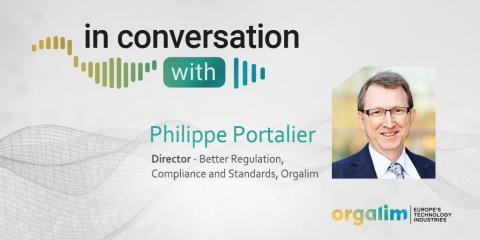In conversation with Philippe Portalier
9 October 2019

In this edition of ‘In conversation with…’ we delve into the wonderful world of standardisation. Philippe Portalier, Director – Better Regulation, Compliance and Standards at Orgalim, talks to us about why standards matter: not only for technology companies looking to boost safety and efficiency when designing their products and services, but for policymakers who want to ensure smooth functioning of the EU Internal Market.
You are responsible for better regulation, compliance and standards at Orgalim – what does that mean in practice?
I work on a range of horizontal policy issues linked to the Internal Market, drawing on over 20 years’ experience in the electrical sector in particular. At Orgalim our top priority is to ensure this European framework supports the competitiveness of our technology companies. The principle of ‘better regulation’ is central to that mission – legislation that is simple to understand, apply and enforce on the ground.
A good example of better regulation is the ‘New Legislative Framework’ (NLF), which has governed practically all products manufactured by our industries for over a decade. In most sectors, it allows companies to self-declare that their products comply with the legal requirements on health and safety or environmental protection. This avoids the need for costly and time-consuming external certification. Compliance checks are then carried out by market surveillance authorities in the Member States to combat fraud and create a level playing field – another important topic for the technology industries we represent.
So ‘better regulation’ is about shaping a framework that protects end-users while working well for business; ‘compliance’ is about demonstrating that products meet all the necessary legal requirements. Where do standards come into the picture?
An important element of the NLF stems from what is known as the ‘New approach to technical harmonisation’ introduced in the 1980s. Behind the jargon lies a very practical concept: under the New Approach, the law only defines the ‘essential requirements’ for a category of products. Technical details are not specified in legislation but rather are given by voluntary standards – European harmonized standards to be precise. This gives companies greater flexibility, as they are free to choose the standards they use to demonstrate compliance with the legal essential requirements.
Moreover, the use of harmonised European standards helps companies to trade seamlessly across borders in the Internal Market. These standards are created by industry and other stakeholders in open, transparent and inclusive European forums – CEN, CENELEC and ETSI – following requests from the European Commission. Once the Commission has reviewed them, the references of these standards are published in the Official Journal of the European Union. This means they are formally available for use, and this will be recognised by authorities in the Member States.
For companies, the benefit is that once a standard is cited in the Official Journal, they can use it to demonstrate that their products comply with the relevant legislation: as we say in the standardisation lingo, it grants ‘presumption of conformity’ with the law. This eliminates the red tape that can go along with national procedures for declaring conformity, avoiding additional cost.
But let’s zoom out for a minute: what exactly is a standard, and why are they so important for the technology industries?
First and foremost, a standard is a sort of technical ‘recipe’ that sets out a uniform approach to a repetitive task when manufacturing a product or providing a service. Take the sheet of paper you’re writing on: A4 – that’s a standard. The protocols underpinning mobile communications – 4G, 5G – or the USB connectors for your computer equipment… all variants of standards.
In essence, a standard is a reference point. The English word comes from the old French word ‘estandard’ – like the ‘royal standard’, this was a flag carried by a prince for his troops to rally around in battle. By using these ready-made and continuously updated technical references, companies can become more efficient and ensure performance and interoperability for their products.
In addition to this technical dimension, standards in the EU context can open up the Single Market for manufacturers. Once a standard is recognised as a European harmonised standard as I explained earlier, all conflicting national standards must be withdrawn.
Industry and policymakers share a commitment to the smooth functioning of the Internal Market – and ensuring an efficient and market-relevant European standardisation system plays a crucial role in achieving that.
What is Orgalim’s role in this standardisation process?
Orgalim is not involved in producing standards directly; rather our work focuses on the political level to ensure that the framework governing the role of standards in the application of product legislation remains flexible and efficient. As I mentioned our main goal is to support the competitiveness of our companies – and simple, efficient conformity assessment procedures are essential to this.
And is the EU standardisation system delivering on these aims?
Although the New Approach has been highly effective in supporting the free circulation of products in the Internal Market, we have seen some bureaucratic hurdles emerge in recent years. Since the adoption of the 2012 Regulation on European Standardisation, the Commission has taken a more legalistic approach to its role in standardisation – particularly when it comes to validating standards for citation in the Official Journal, which is leading to serious delays.
What sort of an impact is this having on companies?
The consequences can be significant, particularly in those cases where legislation mandates the use of harmonised standards. To explain: the use of European standards is generally voluntary. Companies often choose to use them given the benefits on offer, but they are also free to demonstrate compliance in other ways. However in certain areas – like radio equipment – if harmonised standards are not available, companies must undergo external certification processes. So delays in the publication of standards can translate into hefty costs not necessarily foreseen during product development, delaying the time to market. This is particularly detrimental for small and medium-sized enterprises.

How serious could the consequences be for the Internal Market?
In the worst-case scenario where trust breaks down further, we could see industry stakeholders turning away from the formal European standardisation system.
It’s important to understand that 95% of the cost of creating European standards is covered by private companies that send experts to participate in national and European standardisation committees on a voluntary basis. Considering the average cost to produce one standard totals around €1 million, that’s a lot of money that does not directly contribute to a company’s bottom line. If these experts decide the process in the EU context is overly bureaucratic, they may decide to go elsewhere. And without the buy-in of industry stakeholders, the system ceases to serve its purpose of facilitating the placing of goods on the Single Market in a timely and cost-effective manner.
We need to renew dialogue between policymakers and the standardisation community, and work together to find pragmatic solutions.
We also have to think about standardisation in the context of Europe’s international competitiveness. Quite often, the standards we use here in the EU are derived from international standards. That can be advantageous, as it grants companies access not only to the Single Market but to a global marketplace. But if the availability of European standards is delayed by bureaucratic hurdles, we will be lagging behind non-EU competitors that are already deploying the equivalent international standards.
So what would your main message be to the new European Commission as they take office in the coming months?
We need to renew dialogue between policymakers and the standardisation community, and work together to find pragmatic solutions. We share a commitment to the smooth functioning of the Internal Market – and ensuring an efficient and market-relevant European standardisation system plays a crucial role in that.
When the New Approach was introduced, it was a model of better regulation: making use of something that already exists, deployed voluntarily by private operators to support collective goals like safety and quality for the benefit of society at large. The only way to safeguard these benefits is if each stakeholder group – policymakers, standardisation organisations, industry and national authorities – trusts that the system works correctly and trusts each other to carry out their role to the best of their abilities.
For more on Orgalim's recommendations for the future of the European standardisation system, read our latest position paper here.